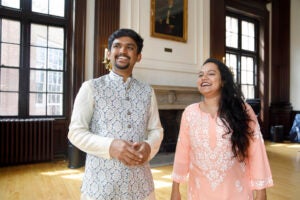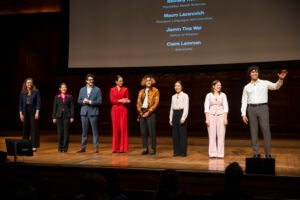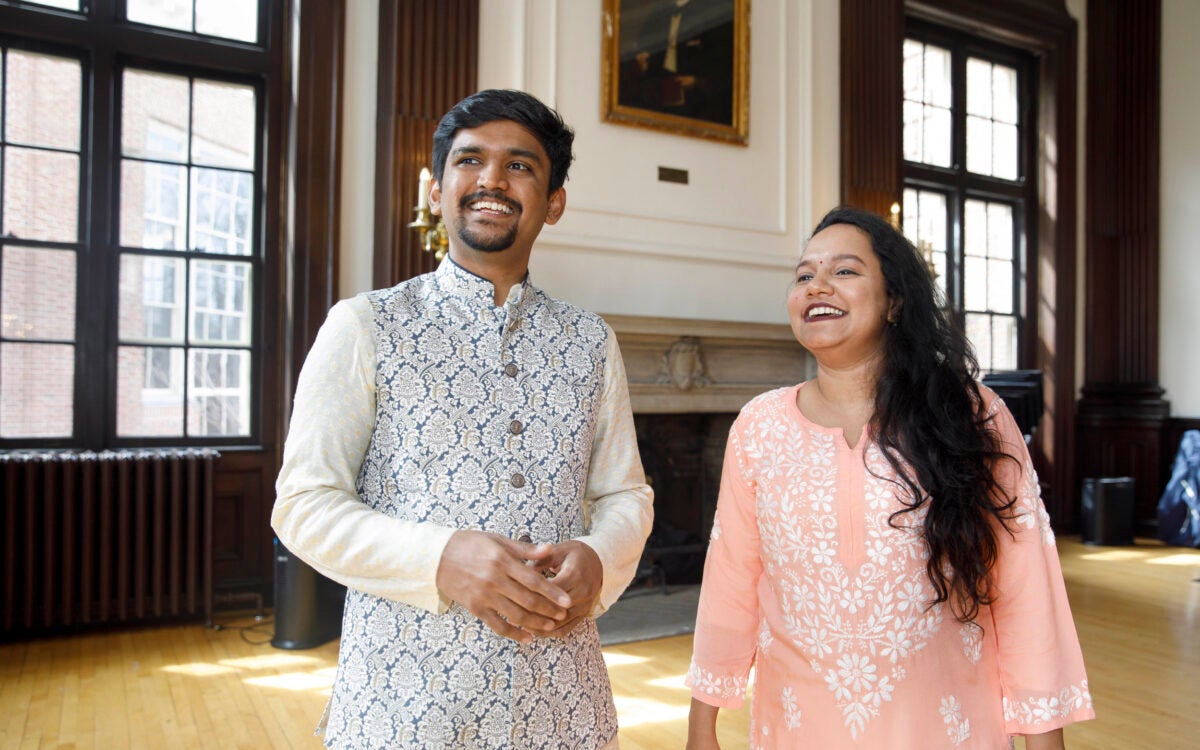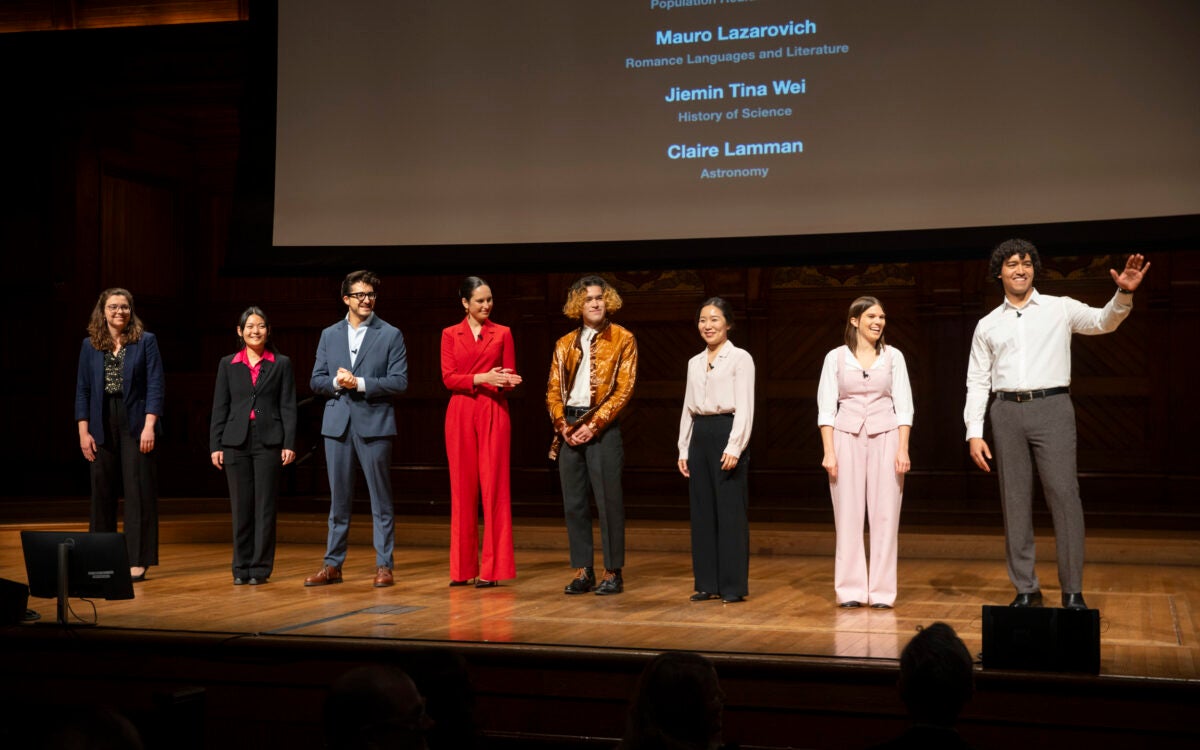Harvard gets a southern exposure:
Telescopes will look toward the edge of the universe
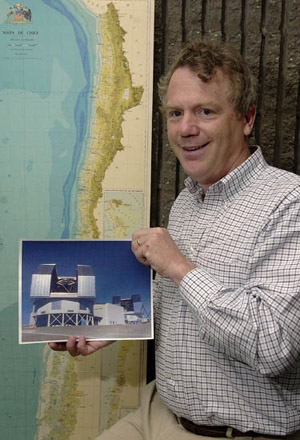
A telescope that allows Harvard astronomers to see heavenly sights invisible from the Northern Hemisphere will be dedicated on Saturday, Dec. 9.
Located on a 7,800-foot-high mountaintop in Chile, the primary mirror of the telescope weighs more than 11 tons and is 21 feet across. Astronomers expect it will gather enough light for them to see 90 percent of the way to the edge of the universe, or as far back in time as 13-14 billion years.
High, dry, and dark, the site provides one of the best places on Earth to see light that has been traveling toward us for billions of years. “It’s an inspiring place to be on a clear night with the center of the Milky Way directly overhead,” says Robert Kirshner, a professor of astronomy. “You can see light that has been traveling from the center of our galaxy for 10,000 years, or from the far parts of the universe for billions of years.”
The center of the Milky Way cannot be seen well from the Northern Hemisphere; the nearest galaxies to us and a large part of the sky around the South Pole cannot be seen at all.
“Harvard and astronomy have been closely linked from the beginning of our history,” Henry Rosovsky, Geyser University Professor Emeritus, noted in a talk prepared for the dedication. “We first talked about this ‘dream’ [telescope] more than a decade ago. Using an academic sense of time, we can perhaps claim to have achieved success on the fast track.”
The telescope was built and will be operated by a partnership of five institutions: Carnegie Institution of Washington, Harvard, Massachusetts Institute of Technology (M.I.T.), and the universities of Arizona and Michigan. Harvard’s 20 percent share of the $71 million cost comes from private donations.
“None of this would have happened,” adds Rosovsky, “without the intellectual and entrepreneurial drive of Irwin Shapiro (director of the Harvard-Smithsonian Center for Astrophysics) and Bob Kirshner.”
Seeing ‘first light’
The Magellan telescope will be one of a pair operated by the partnership atop the Chilean mountain known as Cerro Las Campanas, some 250 miles north of Santiago.
“After planning got going on the first telescope, the astronomers involved started to think, ‘Hey, we could build two of them,’” Kirshner recalled. “It wouldn’t cost twice as much but we could do twice as much astronomy, and we have the potential to operate them both together as one gigantic instrument.”
Magellan II’s 21-foot (6.5-meter) mirror, cast from 22,750 pounds of glass at the University of Arizona, is scheduled to be finished by the end of this year. Plans call for it to be mounted and operational by mid-2002.
The 50-foot-high, 150-ton Magellan I “saw its first light,” as astronomers say, last Sept. 15. Light streamed onto the telescope’s mirror from a star cluster 20,000 light years (120 quadrillion miles) away. Witnesses saw exceptionally sharp images of the star cluster as it appeared when humans still lived in caves.
Some engineering adjustments have yet to be made, together with the mounting of instruments such as cameras on the telescope. Kirshner expects this work to be finished by next March.
Astronomers who go there to view galaxies and stars, black holes and supernovae won’t have to sit in a cold, dark dome squinting through an eyepiece. Rather, images are sent to computer screens in a heated room. Besides faculty members, postdocs and graduate students will work on the top of the mountain. Eventually, the Harvard team expects to transmit images from Chile to computers at the Cambridge campus. Sights to be seen include ongoing changes in the universe, such as new evidence for a mysterious acceleration in its expansion. Long ago, astronomers concluded that the universe has been expanding since its origin in a primal explosion, the so-called Big Bang, some 15 billion years ago. For decades, they have looked for signs of whether the expansion will go on forever, or will slow, stop, then reverse into a Big Crunch. Since 1998, however, researchers, including Kirshner, have found clues that the expansion is speeding up.
“That was very surprising,” Kirshner says.
Now observations with the Magellans will be combined with those from Northern Hemisphere instruments, including the 21-foot telescope near Tucson that Harvard and the Smithsonian Institution share with the University of Arizona “Such observations may prove that the expansion is not really accelerating,” Kirshner admits. “If so, we may find out that the evolution of the universe is not as simple as we think.”
A lumpy universe
Another change that needs looking into involves the fact that the universe is getting lumpy. Gravity is packing some areas closer together while others grow emptier. Astronomers hope to search far enough back in time to see when this started and how the hands of gravity continue to mold the structure of the universe, including our own galaxy.
In the Northern Hemisphere, the center of the Milky Way appears near the horizon in the constellation Sagittarius. But in northern Chile, it passes directly overhead. Astronomers can better study intriguing evidence of a black hole there. Tremendous concentrations of stellar materials are apparently being drawn into the black hole by the inescapable force of its immense gravity.
“Pointing our instruments in that direction should yield clues to how the Milky Way formed, some 12 billion years ago,” Kirshner explains. “From Las Campanas, we also can view the Large and Small Magellanic Clouds, two of our nearest galactic neighbors. We expect studies of these galaxies to reveal a great deal about how stars are born and die.”
MAGIC views
Once upon a time, the universe consisted of a more or less uniform expanse of hydrogen and helium gas. When stars condensed from these basic elements, heat and pressure in their interiors forged all the heavier, more complex materials such as oxygen, carbon, iron, and calcium. The explosive deaths of stars then scattered these elements into interstellar space.
“This is where the iron in our blood and calcium in our bones originated,” Kirshner says. “We are made of stardust. Observations with Magellan I will help us to understand how that happened.”
Infrared sensors on the telescope enable astronomers to see into the dark, dusty places where gravity is pulling material together to make new stars. When larger stars exhaust their hydrogen fuel, they “die” in gigantic explosions called supernovae. The appearance of these sudden flashes of light cannot be predicted. Nor can stupendous bursts of energy, called gamma ray bursts, which come from unknown sources.
Telescope time is usually scheduled six months or more in advance, making it difficult to take instant pictures of these and other unanticipated events. To solve this problem, Magellan researchers have mounted an instant camera on their first telescope. Called MAGIC (MAGellan Instant Camera), the instrument allows astronomers to quickly focus on sudden flashes of light and bursts of energy that can add significantly to our knowledge of the universe. The camera was built at M.I.T. in collaboration with the Harvard-Smithsonian Center for Astrophysics and support from Raymond and Beverly Sackler.
Among other major donors that made it possible for Harvard to participate in the Magellan project are alums Landon Clay, James S. Smith, and A. Lee Loomis; the Arnold Frese Foundation; and the Perkin Fund.
At Saturday’s dedication, Magellan II will be renamed the Clay Telescope in honor of Landon Clay. Magellan I will be called the Baade Telescope after Walter Baade, a distinguished staff member at Carnegie Observatories.
Summing up the University’s role in the project, Kirshner says that “the telescopes are going to be a very good thing for Harvard faculty, researchers, and students for a very long time.”

